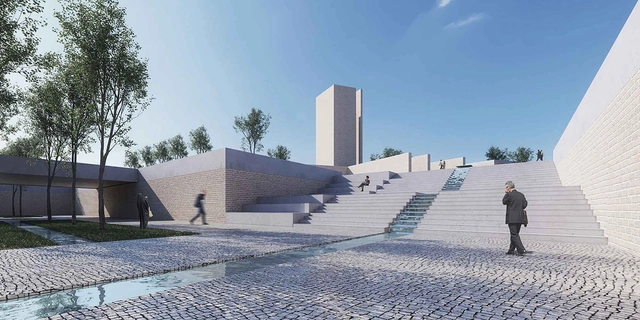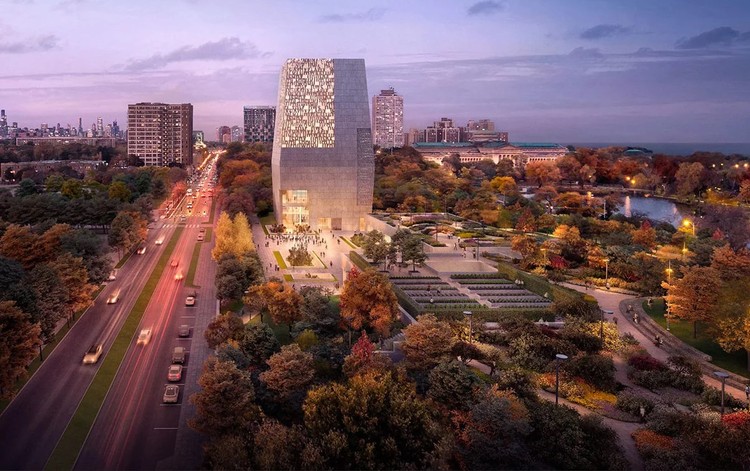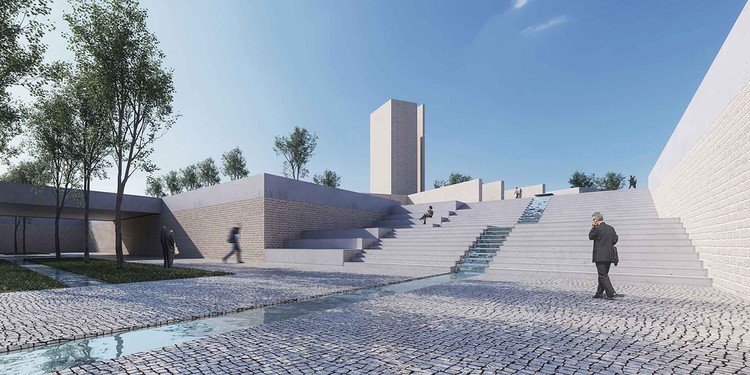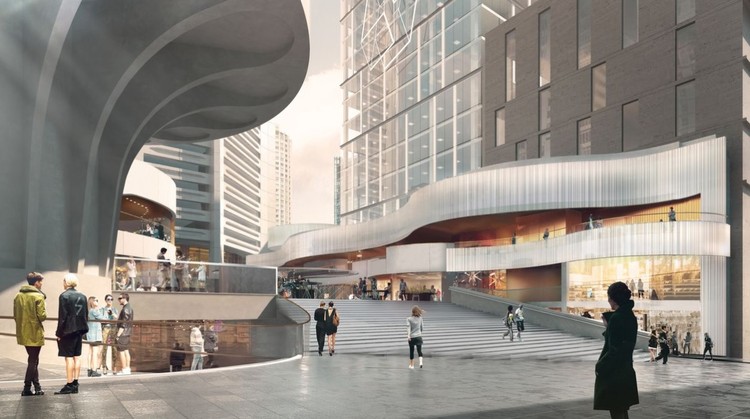Squint/Opera, BIG, and UNStudio have collaborated in the design of Hyperform, a revolutionary data-driven design tool that allows architects across the world to collaborate in augmented reality. The tool allows designers to immerse themselves in a virtual 3D environment, where site images, maps, data, and 3D models can be uploaded, viewed and altered through collaboration.
Architecture News
Obama Presidential Center Design Moves Forward as Federal Judge Rejects Lawsuit

The Obama Presidential Center by Tod Williams Billie Tsien Architects and Interactive Design moves forward as a federal judge tossed out the lawsuit against it. The planned $500 million, 20-acre campus faced an initial ruling from a district judge that allowed the lawsuit to proceed and stalled construction for four months. Now U.S. District Judge John Robert Blakey stated there will be no halt in construction.
First Look at the 2019 Serpentine Pavilion
_2655.jpg?1560892327&format=webp&width=640&height=580)
Japanese architect Junya Ishigami's 2019 Serpentine Pavilion is taking shape in London. A series of photographs by Laurian Ghinitoiu showcase the project and its flowing, free-form roof. Ishigami is the second-youngest designer of the pavilion, and his work is known for a light and ephemeral approach. The design for the 2019 pavilion takes the form of a slate sheet rising from the landscape of the park, held up by pilotis that form an interior field.
Second Home to Open Vibrant Los Angeles Campus

Second Home, a London-based creative business, is set to open its first location the U.S. Designed by Madrid-based Selgascano, the project will see the transformation of the historic site of the Anne Banning Community house in East Hollywood through a 90,000-square-foot urban campus.
Saffar Studio Seeks to Redefine the Iranian Mosque Typology

Saffar Studio has released details of their proposed Golshahr Mosque and Plaza in Alborz, Iran. Inspired by a dialogue between context and function, the scheme is driven by a desire to increase sociability and the interactions between people in a sustainable platform.
ArchDaily's Sustainability Glossary : G-H-I

It is expected that within the next few of decades, Earth will have absolutely nothing left to offer whoever/whatever is capable of surviving on it. Although the human race is solely responsible for the damages done to the planet, a thin silver lining can still be seen if radical changes were to be done to the way we live on Earth and how we sustain it.
Since architects and designers carry a responsibility of building a substantial future, we have put together an A-Z list of every sustainability term that you might come across. Every week, a new set of letters will be published, helping you stay well-rounded on everything related to sustainable architecture and design. Here are the terms that start with letters G, H, and I.
21 Rules for a Successful Life in Architecture

Originally published by Entrepreneur Architect, Associate Professor at Louisiana Tech Kevin J Singh gives his 21-point rundown of how to have a successful and happy life as an architect. The list gives some pointers that will certainly help young students and graduates, but may well be useful to some of the not-so-young practitioners who need to refocus on what's important.
The following is a compilation of my professional practice lecture on the last day of class. Instead of recapping the course or giving a final exam, I share with my students a presentation titled Advice as You Finish School and Start to Practice. I present a series of statements followed up with a brief explanation.
Publicity of the Preliminary Qualification Review Result for the Bidding of Curator of the Opening Ceremony of Brewery Arts Festival and Architectural Exhibition (Luohu•2021)

The preliminary qualification review on the bidding of Curator of the Opening Ceremony of Brewery Arts Festival and Architectural Exhibition (Luohu•2021) has been completed. The result is hereby publicized as follows:
Woods Bagot and Seidler Begin MLC Centre Redevelopment in Central Sydney

Woods Bagot and Harry Seidler and Associates have begun construction on the MLC Centre redevelopment in central Sydney. The $170 million project includes four floors of retail, commercial and cultural spaces across 6,000 square meters. First unveiled in 2015, the project was designed to play on the geometry of the existing MLC tower and forecourt.
Hout Exploits Passive Techniques for Bangladesh Office Building

Hout Architecture has released details of their BERC Headquarters in Dhaka, which received an honorable mention in an international competition for the design of the Bangladesh Energy Regulatory Commission head office. Located in the center of the Sher-e-Bangla Nagar area, orientated along an east-west direction, the program connects to the National Parliament House, designed by Louis Kahn.
Big Bang Brainstorm: Be Inspired by NASA’s Free Images of Outer Space

Architects often look for inspiration in anything and everything around them: forms, volumes, artwork, music, nature… But some sources (and projects) are just out of this world. Literally.
NASA has created an online library of 140,000 high-resolution photos, videos, and sound clips, all free and available for download. Here is a selection of images for your dose of interstellar inspiration.
Studio Gang Breaks Ground on Museum of Natural History Expansion in New York

Studio Gang has broken ground on the American Museum of Natural History Expansion in New York. Called the Richard Gilder Center, the project held its groundbreaking ceremony on June 12 to kick off construction. Designed by Jeanne Gang, the $383 million Center was first proposed seven years ago. The project was made to link a range of museum buildings for better circulation throughout the campus.
Follies and Monuments


My commitment to pavilions—to the idea of making constructional follies—is connected with needing to develop prototypes and carry out constructional research away from the normal practice of architecture. Without being subject to a client’s brief, the pavilions give me an opportunity to develop and test different methodologies, which is something that has always interested me about teaching. They are investigations into various kinds of context, dealing with urban scenarios and landscapes—they are about making something in space for its own sake, when the guiding idea comes from a reading of place. The pavilions fine tune my engagement with a specific situation, allowing me to see what is essential in terms of an action or construction. I did not set out with the idea of working in series, but as different opportunities came up, the process of designing them became more organic, the language seemed to make sense, and as one thing reinforced another, they took on a life of their own.
Aerial Futures Explores the Future of Urban Air Mobility in New Video
Advances in technology have changed the way people work and move around congested cities. Since free space in these urban areas has become scarce, people have shifted their perspective upwards and are now looking to the sky for new means of mobility, transporting their goods via cargo drones and flying ‘taxis’.
Saint-Gobain Announces Winners of International Student Design Competition

Competing in this year’s 15th annual Multi Comfort Student Contest, Saint-Gobain had over 2,200 students from 199 universities worldwide. The final was narrowed down to 60 competing teams from 34 countries, all of whom traveled to Milan to present their designs to an international panel of experts from the Municipality of Milan. This year’s brief was to design a project to rehabilitate and reconnect the urban area around Crescenzago subway station in Milan in line with the city’s #milano2030 development plan. The competition also focuses on Saint-Gobain’s concept of Multi Comfort: thermal, visual, and acoustic comfort, as well as good indoor air quality.
Mayank Thammalla Transforms the Venetian Canals into an Architectural Canvas

Nothing is ordinary about the Italian city of Venice. Whether it is the vividly-colored architecture that dates back to Gothic and Byzantine eras, or the fact that the city is floating on water, culturally-rich Venice is an intriguing destination for people of all backgrounds and interests.
With every visit to Venice, London-based architect and photographer Mayank Thammalla found himself discovering new scenic views of the city, ones that are often tucked beneath its architecture. In his recent photographic series ‘Echoes of Venice’, Thammalla used the canal ripples as his canvas and displayed the deteriorating architecture of Venice from a unique, inverted perspective.
Fundamental and Omega Design "Tower of the Sun" High-Rise Over Kazakhstan's Ishim River

Rotterdam-based Fundamental Architects and Omega Render have designed an iconic high-rise and bridge over Ishim River in Kazakhstan. Made for the country's largest developer, BI GROUP, the 75.000 sq. meter mixed-use building is sited in the heart of Astana. Reaching a height of 121 meters over the river Ishim, the building is set to become a new home for residential, office, hotel and commercial functions as an infrastructural hub.
White Arkitekter Create Lattice Observation Tower in Sweden

Scandinavian firm White Arkitekter has won an architectural competition for a landmark 12-meter-tall observation tower, hosted by the municipality of Varberg, Sweden. The winning proposal will form part of the development of the region’s new ecological recreation area at the Getterön nature reserve.
ArchDaily Topics - June: Travel

As architects, we are on an endless journey of discovery, open to new experiences that fuel our creativity. We explore our surroundings and beyond, we travel to expand our views and open our mind, being often exposed to the unexpected. All these experiences are stored in our mental hard drive until the inspiration moment comes, drawing random non-linear connections between them and putting us into a state of divergent thinking, from where new ideas appear.
Continuity and Sensitivity Drive the Designs of Ricardo Bak Gordon
_0001.BOLIQUEIME.PUB-FG01.06.jpg?1560477890&format=webp&width=640&height=580)
Past, Present, Future is an interview project by Itinerant Office, asking acclaimed architects to share their perspectives on the constantly evolving world of architecture. Each interview is split into three video segments: Past, Present, and Future, in which interviewees discuss their thoughts and experiences of architecture through each of those lenses. The first episode of the project featured 11 architects from Italy and the Netherlands and Episode II is comprised of interviews with 13 architects from Spain, Portugal, France, and Belgium.







_2741.jpg?1560892362)
_2541.jpg?1560892289)
_2605.jpg?1560892300)
_2763.jpg?1560892398)
_2655.jpg?1560892327)


































.jpg?1560394338)



















_0001.BOLIQUEIME.PUB-FG01.06.jpg?1560477890)
_Teatro_Romano_N.Central_Entrada.jpg?1560477635)
_Casa_na_Costa_do_Castelo_RBG_37.jpg?1560477725)
_School_Romanshorn_BER04.jpg?1560477676)
_0001.BOLIQUEIME.PUB-FG01.06.jpg?1560477890)